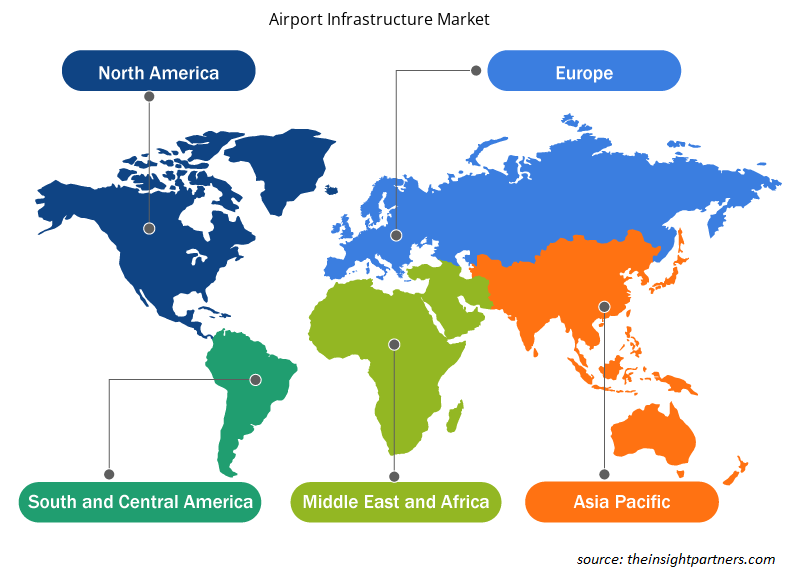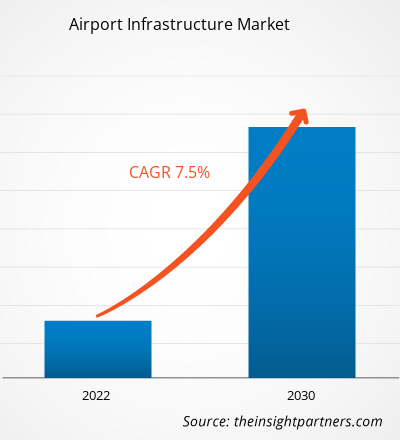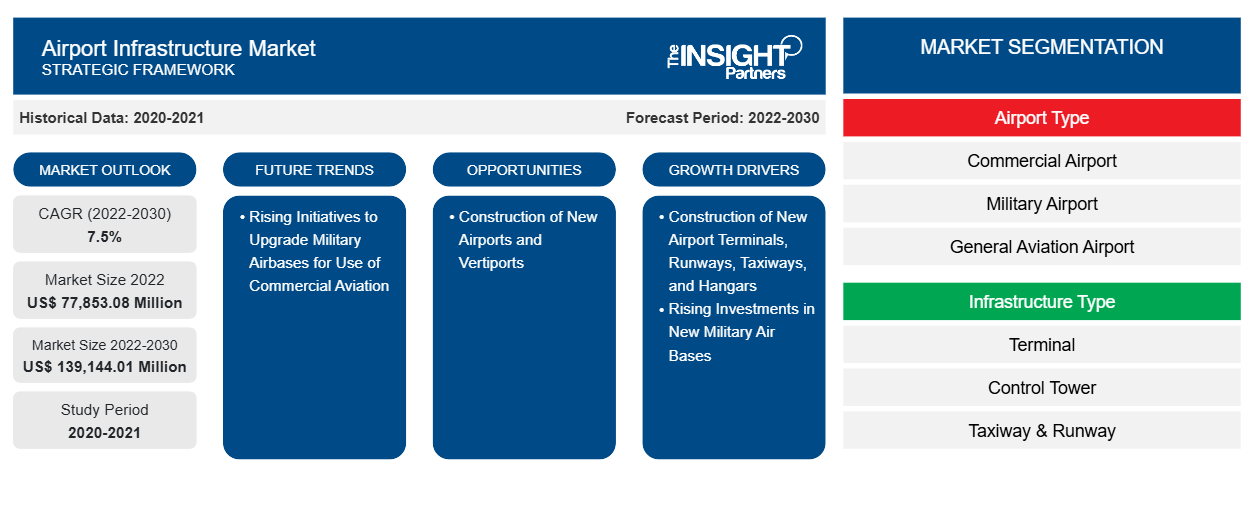공항 인프라 시장 규모는 2022년 77,853.08백만 달러에서 2030년까지 139,144.01백만 달러에 도달할 것으로 예상됩니다. 이 시장은 2022~2030년에 7.5%의 CAGR을 기록할 것으로 예상됩니다. 여러 국가의 정부는 증가하는 항공기 함대와 승객 수에 부응하기 위해 새로운 공항을 건설하기 위한 이니셔티브를 취해 왔습니다. 예를 들어, 2022년에 인도 정부는 2025년 말까지 220개의 상업 공항을 건설할 계획을 발표했습니다. 게다가 2018년에 중국 민간 항공국(CAAC)은 2035년 말까지 216개의 새로운 공항을 건설할 계획을 발표했으며, 이로써 2035년까지 총 공항 수가 450개로 늘어날 것입니다(2023년에는 현재 234개의 공항). 이러한 발전은 전 세계 상업 공항 부문의 공항 인프라 시장 성장을 촉진해 왔습니다.
공항 인프라 시장 분석
군용 공항과 새로운 공군 기지에 대한 수요는 여러 지역의 국가 간의 세계적 긴장이 고조됨에 따라 증가하고 있습니다. 많은 국가가 임무 관련 기술을 조달하고 각 목표 위치에 새로운 기지를 건설하기 위해 각자의 군사 투자를 추진해 왔습니다. 게다가 더 많은 수의 군용 항공기를 수용하기 위해 기존 군용 공항을 확장하면서 전 세계 군용 공항 부문의 공항 인프라 시장 이 성장하고 있습니다 . 예를 들어, 2021년 9월 중국 정부는 이 지역의 민간 및 군용 공항 인프라를 강화하기 위해 티베트와 신장성에 30개의 새로운 공항을 건설했다고 발표했습니다. 게다가 인도군이 이전에 발표한 59개 공항 건설 계획도 진행 중입니다. 2023년 11월 말까지 인도는 각자의 작전을 위해 약 39개의 군용 공항을 보유했습니다. 이러한 발전은 군용 공항 부문의 공항 인프라 시장 성장을 촉진해 왔습니다.
공항 인프라 시장 개요
일반 항공 공항은 기본적으로 이륙, 착륙, MRO 서비스, 운영 점검 및 개인 전세 운항과 같은 운항을 위해 비즈니스 제트기, 피스톤 엔진 항공기, 헬리콥터 및 트레이너 항공기를 제공합니다. 미국, 중국, 러시아 및 영국과 같은 여러 국가는 이미 더 많은 수의 일반 항공 공항을 보유하고 있으며, 이는 각 지역 전역에 걸쳐 공항 확장 프로젝트를 통해 일반 항공 공항 부문의 공항 인프라 시장 성장을 주도하고 있습니다. 예를 들어, 2023년 9월, 미국 샌프란시스코 만 지역의 주요 일반 항공 공항(산 카를로스 공항) 중 하나는 50,000제곱피트의 새로운 격납고 공간과 22,000제곱피트의 공용 구역, 사무실 공간 및 회의실을 위한 공항 업그레이드에 대한 투자를 발표했습니다. 게다가 2020년에는 델리의 인디라 간디 국제공항도 비즈니스 제트기 운항을 위한 새로운 터미널을 개장했습니다. 이러한 개발은 일반 항공 공항 부문의 공항 인프라 시장 성장을 촉진해 왔습니다.
귀하의 요구 사항에 맞게 이 보고서를 사용자 정의하세요
이 보고서의 일부 또는 국가 수준 분석, Excel 데이터 팩을 포함하여 모든 보고서에 대한 사용자 정의를 무료로 받을 수 있으며 신생 기업 및 대학을 위한 훌륭한 혜택과 할인 혜택을 이용할 수 있습니다.
-
이 보고서의 주요 시장 동향을 알아보세요.이 무료 샘플에는 시장 동향부터 추정 및 예측까지 다양한 데이터 분석이 포함됩니다.
공항 인프라 시장 동인 및 기회
새로운 공항 터미널, 활주로, 유도로 및 격납고 건설 증가
증가하는 글로벌 상업용 항공기 함대는 전 세계적으로 증가하는 승객 교통량을 처리하기 위해 다양한 공항에 걸쳐 새로운 항공편, 터미널, 활주로 및 격납고에 대한 수요를 생성하는 주요 요인 중 하나입니다. 또한 이는 공항 당국이 더 많은 수의 항공기를 처리하기 위해 각 공항 구내를 업그레이드하기 위한 투자를 촉진하여 전반적인 공항 운영 효율성도 개선합니다. 이는 또한 전 세계적으로 항공 승객 교통을 지원해 온 저비용 항공사의 도입으로 뒷받침됩니다. 2023년 3월, 캐나다 켈로나 시의회는 켈로나 공항 터미널 확장 프로젝트에 9,000만 달러의 자금 지원을 승인했다고 발표했습니다. 여러 국가의 여러 정부 당국도 국제 화물 무역과 항공 여행 산업의 흐름을 개선하기 위해 각국에 새로운 공항을 건설할 계획을 세웠습니다. 예를 들어, 미국에서는 현재 6개의 새로운 공항이 건설 중입니다. 또한 2022년 인도 정부는 2025년 말까지 220개의 공항을 건설할 계획을 발표했습니다. 게다가 2018년 중국 민간 항공국(CAAC)은 2035년 말까지 216개의 신공항을 건설할 계획을 발표했으며, 2035년까지 총 공항 수를 450개(2023년 현재 234개 공항)로 늘릴 가능성이 높습니다. 따라서 새로운 공항 터미널, 활주로, 유도로, 격납고의 건설은 전 세계 공항 인프라 시장의 성장에 기여합니다.
상업 항공 사용을 위한 군용 비행장 업그레이드를 위한 이니셔티브 증가
여러 국가의 정부는 새로운 상업 공항이 운영될 때까지 다양한 지역에서 증가하는 승객 교통을 관리하는 데 더 나은 편의성을 제공하기 위해 각자의 군 공항이 상업 항공기 착륙 및 운영을 허용하도록 이니셔티브를 취하고 있습니다. 몇 가지 다른 이니셔티브로는 일부 군 공항을 하이브리드 공항으로 업그레이드하는 것이 있습니다. 예를 들어, AF Plant 42(캘리포니아주 팜데일), Barter Island LRRS(바터 아일랜드), AK Charleston AFB(사우스캐롤라이나주 찰스턴), Dover AFB(델라웨어주 도버), Eglin AFB(플로리다주 발파라이소), Grissom AFB(인디애나주 페루), Kelly/Lackland AFB(텍사스주)와 같은 미국의 여러 군 공항은 민간 후원자가 군 비행장을 착륙 또는 이륙 운영에 사용하려는 경우 이러한 기존 군 공항을 공동으로 사용할 수 있도록 허용합니다. 따라서 상업 항공 에 사용할 군 공군 기지를 업그레이드하려는 이니셔티브가 증가 함에 따라 예측 기간 동안 공항 인프라 시장이 성장할 것으로 예상됩니다.
공항 인프라 시장 보고서 세분화 분석
공항 인프라 시장 분석에 기여한 주요 세그먼트는 공항 유형, 인프라 유형 및 지리입니다.
- 공항 유형에 따라 공항 인프라 시장은 상업 공항, 군 공항, 일반 항공 공항으로 세분화되었습니다. 상업 공항 세그먼트는 2022년에 더 큰 시장 점유율을 차지했습니다.
- 인프라 유형별로 공항 인프라 시장은 터미널, 관제탑, 유도로 및 활주로, 격납고 및 기타로 세분화되었습니다. 터미널 세그먼트는 2022년에 시장에서 가장 큰 점유율을 차지했습니다.
지역별 공항 인프라 시장 점유율 분석
공항 인프라 시장 보고서의 지리적 범위는 주로 북미, 유럽, 아시아 태평양, 중동 및 아프리카, 남미의 5개 지역으로 나뉩니다.
아시아 태평양 지역은 2022년 공항 인프라 시장을 지배했으며, 예측 기간 동안에도 지배력을 유지할 것으로 예상됩니다. 또한 아시아 태평양 지역은 2022~2030년 동안 공항 인프라 시장에서 가장 높은 CAGR을 기록할 가능성이 높습니다. 이는 이 지역의 공항 시설 확장 및 현대화에 대한 투자가 증가했기 때문입니다. 또한 아시아 태평양 지역은 이 지역의 강력한 경제 성장과 항공 여행의 급증에 힘입어 공항 인프라 개발을 위한 역동적인 허브로 자리 잡고 있습니다. 중국과 인도와 같은 국가는 새로운 공항 건설 및 확장 프로젝트에 막대한 투자를 목격하고 있습니다. 이러한 이니셔티브는 증가하는 승객 수에 발맞추고 지역 연결성을 촉진하는 것을 목표로 합니다.
공항 인프라 시장 지역 통찰력
Insight Partners의 분석가들은 예측 기간 동안 공항 인프라 시장에 영향을 미치는 지역적 추세와 요인을 철저히 설명했습니다. 이 섹션에서는 북미, 유럽, 아시아 태평양, 중동 및 아프리카, 남미 및 중미의 공항 인프라 시장 세그먼트와 지리에 대해서도 설명합니다.

- 공항 인프라 시장에 대한 지역별 특정 데이터 얻기
공항 인프라 시장 보고서 범위
| 보고서 속성 | 세부 |
|---|---|
| 2022년 시장 규모 | 77,853.08백만 달러 |
| 2030년까지 시장 규모 | 139,144.01백만 달러 |
| 글로벌 CAGR (2022-2030) | 7.5% |
| 역사적 데이터 | 2020-2021 |
| 예측 기간 | 2022-2030 |
| 다루는 세그먼트 |
공항 유형별
|
| 포함된 지역 및 국가 |
북아메리카
|
| 시장 선도 기업 및 주요 회사 프로필 |
|
공항 인프라 시장 참여자 밀도: 비즈니스 역학에 미치는 영향 이해
공항 인프라 시장 시장은 소비자 선호도의 변화, 기술 발전, 제품의 이점에 대한 인식 증가와 같은 요인으로 인해 최종 사용자 수요가 증가함에 따라 빠르게 성장하고 있습니다. 수요가 증가함에 따라 기업은 제품을 확장하고, 소비자의 요구를 충족하기 위해 혁신하고, 새로운 트렌드를 활용하여 시장 성장을 더욱 촉진하고 있습니다.
시장 참여자 밀도는 특정 시장이나 산업 내에서 운영되는 회사나 기업의 분포를 말합니다. 주어진 시장 공간에 얼마나 많은 경쟁자(시장 참여자)가 존재하는지 그 규모나 전체 시장 가치에 비해 나타냅니다.
공항 인프라 시장에서 운영되는 주요 회사는 다음과 같습니다.
- 헨셀 펠프스
- 에이컴
- 터너 건설 회사
- 스칸스카
- 오스틴 인더스트리
면책 조항 : 위에 나열된 회사는 어떤 특별한 순서에 따라 순위가 매겨지지 않았습니다.

- 공항 인프라 시장 주요 주요 업체 개요를 알아보세요
공항 인프라 시장 뉴스 및 최근 개발
공항 인프라 시장은 1차 및 2차 조사 이후의 질적, 양적 데이터를 수집하여 평가합니다. 여기에는 중요한 기업 간행물, 협회 데이터 및 데이터베이스가 포함됩니다. 다음은 공항 인프라 시장과 전략에 대한 시장의 개발 목록입니다.
- 2023년에 Hensel Phelps는 콜럼버스 지역 공항청(CRAA)에 의해 존 글렌 콜럼버스 국제공항의 신규 터미널 프로젝트에 대한 위험 관리 건설 관리자(CMaR)로 임명되었습니다. 이 프로젝트의 사전 건설 및 건설 서비스는 Hensel Phelps | Elford 팀이 제공합니다. 이 프로젝트를 통해 Hensel Phelps는 오하이오 시장에 진출하고 CRAA 및 Elford와의 파트너십을 강화합니다. (출처: Hensel Phelps, 보도자료/회사 웹사이트/뉴스레터)
- 2022년 AECOM은 HJ Russell & Company, Airfield Management Partners와의 합작 투자가 Dallas Fort Worth International Airport에서 민간 에어사이드 프로그램 및 건설 관리 서비스를 제공하도록 선정되었다고 발표했습니다. (출처: AECOM, 보도자료/회사 웹사이트/뉴스레터)
공항 인프라 시장 보고서 범위 및 제공물
"공항 인프라 시장 규모 및 예측(2020-2030)" 보고서는 아래 영역을 포괄하는 시장에 대한 자세한 분석을 제공합니다.
- 범위에 포함된 모든 주요 시장 세그먼트에 대한 글로벌, 지역 및 국가 수준의 시장 규모 및 예측
- 동인, 제약 및 주요 기회와 같은 시장 역학
- 주요 미래 트렌드
- 포터의 5가지 힘에 대한 자세한 분석
- 주요 시장 동향, 주요 업체, 규정 및 최근 시장 동향을 포괄하는 글로벌 및 지역 시장 분석
- 시장 집중도, 히트맵 분석, 유명 기업 및 최근 개발 사항을 포함하는 산업 환경 및 경쟁 분석
- SWOT 분석을 통한 자세한 회사 프로필
- 과거 분석(2년), 기준 연도, CAGR을 포함한 예측(7년)
- PEST 및 SWOT 분석
- 시장 규모 가치/거래량 - 글로벌, 지역, 국가
- 산업 및 경쟁 환경
- Excel 데이터세트
최근 보고서
사용 후기
구매 이유
- 정보에 기반한 의사 결정
- 시장 역학 이해
- 경쟁 분석
- 고객 인사이트
- 시장 예측
- 위험 완화
- 전략 기획
- 투자 타당성 분석
- 신흥 시장 파악
- 마케팅 전략 강화
- 운영 효율성 향상
- 규제 동향에 발맞춰 대응























 무료 샘플 받기 - 공항 인프라 시장
무료 샘플 받기 - 공항 인프라 시장